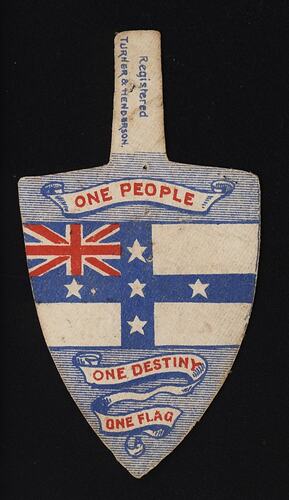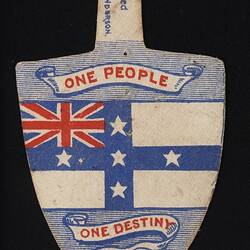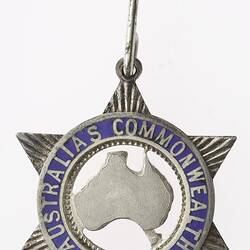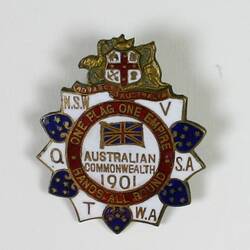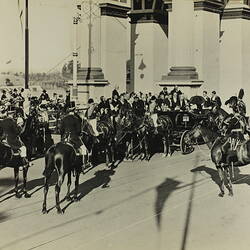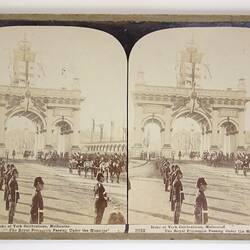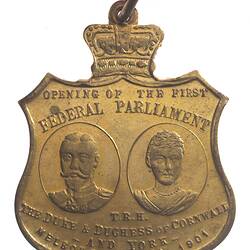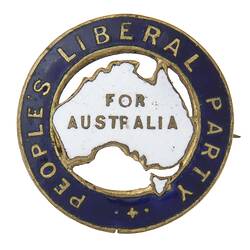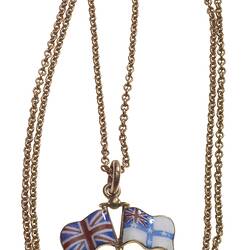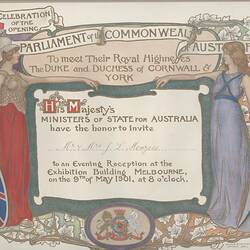Summary
Australia became a nation when the six self-governing colonies united in 1901. Before this, the colonies were politically separate, with their own laws and parliaments. During the long political process that led to Federation, a stronger sense of Australian nationalism developed. This narrative describes some of the organisations and individuals who supported the move toward Federation.
'The Federal movement was a People's movement. In its inception it sprang from the People and the People have set their seal upon the great cause.' (Editorial in the Mildura Cultivator, 4 May 1901)
From 1901, many writers portrayed the movement for Federation as a popular one, stemming from the people of the colonies of Australia. But, in fact, the idea of Federation did not emerge from a spontaneous popular movement. The initial impetus came from the political leaders in some of the colonies. Later, other community organisations and political interest groups embraced the idea. The final result was achieved through negotiation, compromise and collaboration with many groups of people in the Australian colonies.
Politicians
Politicians were the leaders in the move towards Federation. Politics at the end of the nineteenth century was in a state of flux, governments changed much more quickly than they do today. Coalitions and alliances were frequently formed and reformed. There were generally three political groupings: conservatives, liberals and labour. Federation was not an issue on which there were strong party allegiances. The young Labor Party argued against the proposed constitution, in some colonies, because it felt it was undemocratic, but the party was not against Federation in principle.
The final achievement of Federation was a collaboration, and there were many politicians who contributed significantly. The most well known are men like Alfred Deakin, Edmund Barton, Henry Parkes, Charles Kingston, Andrew Inglis Clark, and Samuel Griffith, but there were many other participants in the process. Many went on to the Federal parliament, where, as Deakin had predicted, politics became dominated by party allegiances rather than state allegiances.
Federal Leagues
In the 1890s clubs and societies were formed to advocate for Federation. Many groups formed in towns along the Murray River because of the effect of customs duties on importing goods. Others joined the Federal Leagues because they felt that Federation could provide greater freedoms and democracy; the right to vote could be extended and the political system made more democratic. Stronger defence against invasion was also a motivation, along with greater immigration restriction, which was advocated by many of the groups. The Leagues played a key role in encouraging popular support for Federation and in shaping the democratic nature of the constitution.
Women's Federal Leagues
Women began their own Federal Leagues in many areas, principally to try and win the right to vote in the new nation. In 1894, they won the vote in South Australia, and in 1899 in Western Australia. In the other colonies they could not yet vote, and many women were determined to win the franchise in Federal elections, and to make sure they did not lose the right in those colonies in which they were already enfranchised.
Catherine Helen Spence stood for election as a delegate to the 1897-98 Federation Convention. The right for women to stand for election had been newly won in South Australia. She was a highly respected public figure, but it was Premier Kingston's male candidates who won the places as South Australian delegates. Spence was also the inventor and advocate of a system of proportional representation, similar to that used in the Senate today. This system allocates seats to parties according to the proportion of votes won overall in an election.
The Australian Natives Association
The Australian Natives Association was an organisation set up in 1871 to provide health and other benefits for white men born in Australia. They were strong nationalists, and were politically active from the 1880s. In 1889 they enthusiastically took up the cause of Federation, and this became one of their main political goals. The colony in which they were most popular was Victoria, which was also the strongest supporter of Federation. Many of the leading federalists such as Alfred Deakin, Isaac Isaacs and George Turner were members of the ANA. In the election for the Victorian delegates of the 1897-98 Federation Convention, ANA men won the first five places. The ANA also played a major role in setting up the Federal Leagues in the 1890s.
The press
Throughout the meetings, conventions and conferences leading up to Federation, the press played an important role. They were admitted to nearly every major discussion, apart from the Premier's Conference of 1899 which they dubbed 'secret'. The two major Victorian newspapers, the Age and the Argus, were both supporters of Federation, the Age being persuaded to this view in the referendum campaign of 1898. David Syme, the proprietor of the Age, was a friend and mentor of Alfred Deakin, and had great power to sway voters and politicians in Victoria. In the 1897 election for the delegates to the Federal Convention all 10 Victorian candidates on the Age ticket were elected.
Lawyers
Writing a constitution for the new nation was a complex task. Different constitutions and political systems from around the world were examined and discussed. Many of the politicians and other proponents of Federation were lawyers. Their expertise greatly aided the drafting of bills and the general understanding of legal issues involved in unifying six colonies into one nation. Samuel Griffith, Charles Kingston, Robert Garran and John Quick were some of the prominent lawyers advocating Federation. Some of the leading federalists also went on to serve on the bench of the newly formed High Court, including Edmund Barton, Samuel Griffith and Isaac Isaacs.
Writers and dreamers
The end of the nineteenth-century was a time when many writers and philosophers were imagining what the future would be like, and how society could be improved. Around the world, modern nation states were forming, and political systems were being invented and reformed. Many people felt that a new nation like Australia could avoid the worst of the Old World, particularly poverty and the class system. Australia would be more democratic, progressive and caring. New books were written depicting utopian visions of a future Australia. In 1888 Catherine Helen Spence wrote a novel in which a woman travels to Australia in 1988 for a week. The woman sees a country improved by better education, legislation and new technology. The people work only a six-hour day and Australia is an independent nation as there is no longer an Empire. Other utopian writing focussed on achieving women's suffrage, improving the tax system, or making Australia wealthier. As well as visions of Australia's future, writers also imagined new political systems and experimental policy in health and education. These new ideas led to discussion and debate, and influenced the federalists, who saw themselves as creating in reality, what had been imagined by writers and philosophers.
The voters
The voters of each colony were asked to approve the constitution for the new nation. Not everyone was eligible to vote. Apart from South Australia and Western Australia, women could not vote in elections. Aboriginal men could not vote in Western Australia or Queensland (unless they owned property valued over £100). Aboriginal women could vote only in South Australia. Other restrictions on adult suffrage applied according to property ownership or income. Voting in elections was not compulsory, so not everyone who could vote, did vote in the referendums. Only 57 per cent of the Victorian electorate turned out to vote in the 1899 referendum. Nevertheless, it was the voters who finally decided that the colonies of Australia would federate.
More Information
-
Keywords
-
Authors
-
Article types
